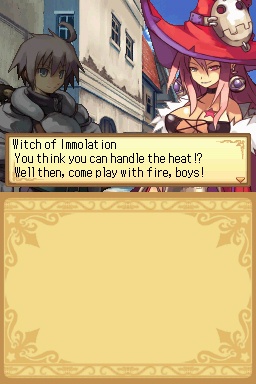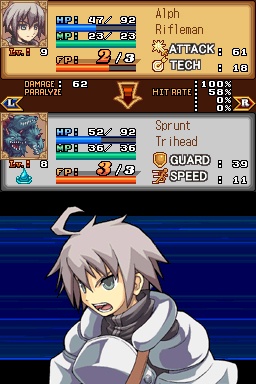It's not hard to find turn-based strategy games on the Nintendo DS to consume your free time, and Luminous Arc is a nice little entry into that niche. While the game's storytelling is a little on the bland side, it's balanced out by a solid battle system and voice work that's good, for the most part. With 25 story chapters and roughly as many hours of gameplay the first time through, this is an accessible tactical adventure with a number of extras to earn and without a bunch of needless level grinding.
The story plunks you down in the world of Shtraberl, governed by a faith known as the Luminous Church. You're introduced to the "Garden Children," a small group of young people under the tutelage of the Arc Knight Heath at a place called the Holy Garden. Their training is completed just in time, as the world is experiencing a monster boom that the church claims is tied to the actions of witches, evil magic users who seek to wreak destruction on the world. The Garden Children are given the task of tracking the witches down and condemning them, which would be a fairly straightforward mission except for one thing: the witches claim that the god of the Luminous Church is actually a planet-eating monster who's due to break his 1,000 year seal and finish lunch.

The characters run a somewhat standard role-playing game gamut, from the light-haired teenage hero Alph and his brother Theo through a host of assorted witches and warriors, including a manatee (OK, so not altogether standard). The story unfolds through a series of chapters that feature a lot of spoken dialogue, which is both a blessing and a curse. Some characters, like the brash and confident Leon, turn in strong and nuanced vocal performances that bring a lot out of the short scripted pieces. There are also a few roles that are completely overdone and detract from the experience (the "valley girl" angel Priel, in particular, is annoying). You don't tend to get into much detail for certain aspects of the story--some pieces of information are gleaned only from visiting town libraries--and the characters themselves don't have a lot of depth, but that's mitigated somewhat by the fact that things move so quickly. There's always a quick bit of action or drama to segue you into battle, and it serves the basic need for impetus well.
Luminous Arc's turn-based battle system is fairly standard at first glance, with grid-based movement and positional attacks playing a role; attacks from the rear are more powerful than from the side, and side attacks are more powerful than hitting a foe head-on. One of the interesting aspects of the system is actually how leveling up is worked into a tactical advantage. Every time characters perform an action, be it a spell, using an item, or attacking a foe, they gain a certain amount of experience. Once they've gotten 100 experience points, they level up. When they do so, their health and magic points go back to completely full, which means that a character in a sticky situation with low health can potentially perform an action, level up, and suddenly be back to full health and possibly be able to move away. This creates a number of opportunities for you to pull off risky tactics or expose units in ways that you ordinarily wouldn't in other strategy games, and it's a really great addition.
Characters have melee abilities, character-specific skills, and spells at their disposal, along with two special attacks, flash drives, and synergies. As you fight, your individual units will accumulate flash points, gradually filling a gauge. When it fills up to the first, second, or third level, that unit can perform the corresponding flash drive, a special attack that does increased damage, sometimes has secondary status effects (like paralyzing enemies or reducing their speed), and often hits multiple foes at a time. These are very effective attacks with an appropriate cost to them; building up FP takes time during the fight, though you can also use items to cheat that a bit. Synergies are another sort of special ability that take multiple characters in close proximity to complete. These combo moves are much harder to pull off because of their individual requirements, but they're satisfyingly strong. Battles in the game offer a good level of challenge, with aggressive enemies and several maps that require quick thinking almost from the start to guide your units out of danger. The gameplay is engaging, and since both character levels and events progress at a good clip, you won't find yourself with a lot of downtime or having to "grind" many battles for experience. Luminous Arc offers an almost perfectly tuned progression from fight to fight.
The game's quite linear, though you do have the option to move around between spots on the world map, picking up the occasional side quest or gathering items to improve your equipment. Called "vitae," these stones are earned through battle and sometimes through conversations with your party members in postbattle "intermissions." When taken to the witch village, these items can be joined to your weapons and armor for increased stats. The only problem with this system is that to reasonably kit out your gear, you want to know what the specific vitae do, and you can find out only by getting the stone appraised. Getting a stone fully appraised costs 2,000 gold, and there are many different sorts of vitae, so if you're regularly buying normal equipment at shops and not doing many extra battles, you can't really afford to do much upgrading unless you want to work at it. It's a fun toy to futz around with if you've got the funds already, but it's definitely not necessary to beat the game.
Finishing the game takes anywhere from about 20-25 hours, and once you've finished it you'll unlock a bunch of extras. There's a nice selection of audio and visual extras--you'll be able to see all the game's story cutscenes and have access to all the audio clips, sound effects, and music. There's also an additional dungeon for you to explore that you can access with a cleared game file, and wireless multiplayer that lets you pit your characters against a friend for some action. It's a good amount of stuff to tinker with, adding good value to an already solid game.

Visually the game employs character portraits and other still art for story sequences, and while there isn't a big variety of different facial expressions, the art has a nice style and each character has its own distinctive look. The battle maps vary over grassy cliffs and plains, castles, beaches, and ice fields and serve as a nice background to the action (the same is true of the game's music). While the voice work does have its ups and downs, the bulk of it is of good quality and adds character to the story and the battles.
Luminous Arc isn't revolutionary and the tale lacks a bit of depth, but the great pacing and enjoyable gameplay gloss over some of those faults. If you like turn-based strategy games and don't mind going through the paces of yet another great evil returning after 1,000 years that can only be stopped by young people with fantastical hair and outfits, certainly give Luminous Arc a look.